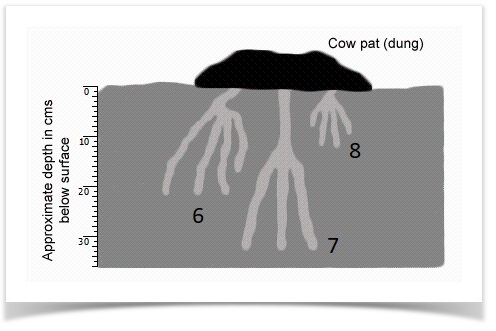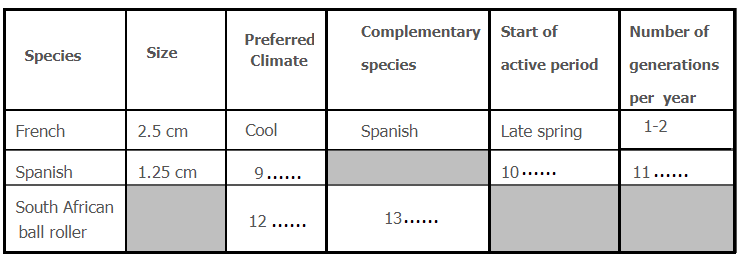A Remarkable Beetle - Answers Explanation
- Details
- Last Updated: Thursday, 29 May 2025 06:09
- Written by IELTS Mentor
- Hits: 25211
Answer explanations - A Remarkable Beetle
Go to the Reading Passage using the link - A Remarkable Beetle
Answer Explanation:
Questions 1-5
Do the following statements reflect the claims of the writer in the Reading Passage?
In boxes 1-5 on your answer sheet write:
YES if the statement reflects the claims of the writer
NO if the statement contradicts the claims of the writer
NOT GIVEN if it is impossible to say what the writer thinks about this
Question 1: Bush flies are easier to control than buffalo flies.
Answer: Not Given.
Keywords: Bush flies, buffalo flies, control.
Answer Explanation: The only reference to controlling any kind of flies – be it bush flies or buffalo flies – is provided in sentence 1 of the 7th paragraph where it says “Dung beetles were initially introduced in the late 1960s with a view to controlling buffalo flies by removing the dung within a day or two and so preventing flies from breeding”.
If we notice carefully, this particular sentence talks about controlling “buffalo flies” only, with no reference anywhere and whatsoever to suggest that bush flies are easier to control than buffalo flies. Other than in this particular reference, there is no other discussion about controlling any kind of flies anywhere else in the passage, so, again, the answer to this question would be “Not Given”.
Question 2: Four thousand species of dung beetle were initially brought to Australia by the CSIRO.
Answer: No.
Keywords: Four thousand species, Australia, CSIRO.
Answer Explanation: Please start reading from the second sentence of the third paragraph where it says “Between 1968 and 1982, the CSIRO imported insects from about 50 different species of dung beetle, from Asia, Europe and Africa, aiming to match them to different climatic zones in Australia”.
Here, the writer clearly states that the CSIRO actually imported about 50 species, not four thousand, to Australia initially – a claim which clearly contradicts the statement above. So, again, the answer to this question should be “No”.
Question 3: Dung beetles were brought to Australia by the CSIRO over a fourteen-year period.
Answer: Yes.
Keywords: Dung beetles, CSIRO, fourteen-year period, Australia.
Answer Explanation: Let us start reading from the second sentence of the third paragraph again which writes “Between 1968 and 1982, the CSIRO imported insects from about 50 different species of dung beetle, from Asia, Europe and Africa, aiming to match them to different climatic zones in Australia”.
Now, according to the statement in the quotation above, the number of years - from 1968 to 1982 - adds up to become exactly 14 years, clearly confirming the statement above. Hence, the answer to this question again is “Yes”.
Question 4: At least twenty-six of the introduced species have become established in Australia.
Answer: Yes.
Keywords: Twenty-six (26), Australia.
Answer Explanation: Please read the final sentence of the third paragraph which says “Of the 26 species that are known to have become successfully integrated into the local environment, only one, an African species released in northern Australia….”
Here the writer clearly mentions the number of species as “26” that have successfully integrated into the local environment (Australian environment that is), and hence the answer to this question is “yes”.
Question 5: The dung beetles cause an immediate improvement to the quality of a cow pasture.
Answer: No.
Keywords: cow pasture, immediate improvement, dung beetles.
Answer Explanation: Please read the entire 4th paragraph of the reading passage to understand the whole process as to how exactly a pasture benefits from the activities of dung beetles:
“Introducing dung beetles into a pasture is a simple process: approximately 1,500 beetles are released; a handful at a time, into fresh cow pats 2 in the cow pasture. The beetles immediately disappear beneath the pats digging and tunnelling and, if they successfully adapt to their new environment, soon become a permanent, self-sustaining part of the local ecology. In time they multiply and within three or four years the benefits to the pasture are obvious.”
Now, if we read the final sentence of this paragraph in bold, we for sure will be able to find out that the dung beetles actually take about three to four years to improve the cow pasture rather than improving it immediately, as the question above suggests. So, the answer to this question, again, is “No”.
Questions 6-8
Label the tunnels on the diagram below. Choose your labels from the box below the diagram.

Question 6:
Question 6 shows a tunnel of approximately 20 cm below the surface of the cow pat (dung).
Answer: South African
Answer Explanation: From the list of dung beetle types, we need to find out which one digs a narrow tunnel of around 20 cm below the surface of the cow pat.
Now if we look at the sixth sentence of paragraph 5, we can find that it says - "South African beetles dig narrow tunnels of approximately 20 cm below the surface of the pat". So, the answer is "South African".
Question 7:
Question 7 shows a tunnel that is approximately 30 cm below the surface of the cow pat or cow dung.
Answer: French
Answer Explanation: From the list of dung beetle types, we need to find out which one digs a narrow tunnel of about 30 cm below the surface of the cow pat.
Again by looking at the 3rd sentence in paragraph 5, we can find that it says - "Some large species originating from France excavate tunnels to a depth of approximately 30 cm below the dung pat.". So, the answer is "French".
N.B. We have to write answers from the list given in the table below the diagram. Since it mentions "French", our answer should be "French". So do not write "French beetles" or "Species from Franch" as they are not correct answers.
Question 8:
Question 8 shows a tunnel that is approximately 10 cm below the surface of the cow pat /dung.
Answer: Spanish
Answer Explanation: From the list of dung beetle types, we need to find out which one digs a narrow tunnel of approximately 10 cm below the surface of the cow pat.
The 5th sentence in paragraph 5, says that - "The shallowest tunnels belong to a much smaller Spanish species that buries dung in chambers that hang like fruit from the branches of a pear tree." So, the answer is "Spanish".
Here, the word "shallowest" means the "least". From the diagram, it is obvious that the tunnel marked as question 8 is the shallowest (i.e. 0-10 cm). So the obvious answer choice is "Spanish".
Questions 9-13
Complete the table below.
Choose NO MORE THAN THREE WORDS OR A NUMBER from the Reading Passage for each answer.

Question 9:
For question 9, we need to find out the preferred climate of Spanish beetles.
Answer: Temperate
To find the answer to question 9, we need to read the 2nd line of paragraph 6. It says that "In the cooler environments of the state of Victoria, the large French species (2.5 cms long) is matched with smaller (half this size), temperate-climate Spanish species."
This line clearly expresses that Spanish beetles are half the size of French species, and they prefer a "temperate" climate. So, the answer is "temperate".
Question 10:
For question 10, we need to find out when is the start of the active period (time to reproduce) of Spanish beetles.
Answer: Early spring
To find the answer to question 10, we need to read the 4th line of paragraph 6. It says that "The latter, which multiply rapidly in early spring, produce two to five generations annually."
This line clearly expresses that Spanish beetles multiply (or grow in number through birth) or start to remain active from early spring. So, the answer is "early spring".
Please note that, in this paragraph, the writer is talking about two beetle species - French species and Spanish species. Frech species are talked about first so they are referred to as "Former", and Spanish as "Latter".
Question 11:
For question 11, we need to find out how many generations the Spanish beetles produce annually or in a year.
Answer: 2- 5 / two to five
To find the answer to question 11, we need to read the 4th line of paragraph 6 again. In fact, the same sentence that reveals the answer to question 10, gives us the answer to question 11 as well. This sentence reads "The latter, which multiply rapidly in early spring, produce two to five generations annually."
This line clearly outlines that Spanish beetles produce 2-5 generations in a year. So, the answer is "2-5" or "two to five".
Question 12:
For this question, we need to figure out the preferred climate of South African ball roller beetles.
Answer: sub-tropical/ subtropical
To figure out the answer to this question, we need to read the 5th line of paragraph 6 (the line before the last line in this paragraph). This sentence reads - "The South African ball-rolling species, being a subtropical beetle, prefers the climate of northern and coastal New South Wales where it commonly works with the South African tunnelling species."
This line clearly outlines that South African ball roller beetles are sub-tropical beetles (which means they prefer sub-tropical climates). So, the answer is "sub-tropical/ subtropical".
Question 13:
For question 13, which is the last question in this reading passage, we need to figure out the name of the complementary species for South African ball roller beetles, i.e. which beetle species work with South African ball roller beetles.
Answer: (South African) tunneling/tunnelling (species)
To figure out the answer to this question, we need to read the 5th line of paragraph 6 again (the line before the last line in this paragraph). This sentence reads - "The South African ball-rolling species, being a subtropical beetle, prefers the climate of northern and coastal New South Wales where it commonly works with the South African tunnelling species."
This line clearly explains that South African boll roller beetles commonly work with (complement with...) South African tunnelling beetle species. So, the answer is "(South African) tunneling/tunnelling (species)".
Please note that the question instruction says that you should use a maximum of three words or a number. So writing "South African tunnelling species" would be a wrong answer as it has more than three words.
This is the end of the "Answer Explanation" section for the reading passage "A Remarkable Beetle".
Do you have any questions? Please leave a comment and let us know.

Report